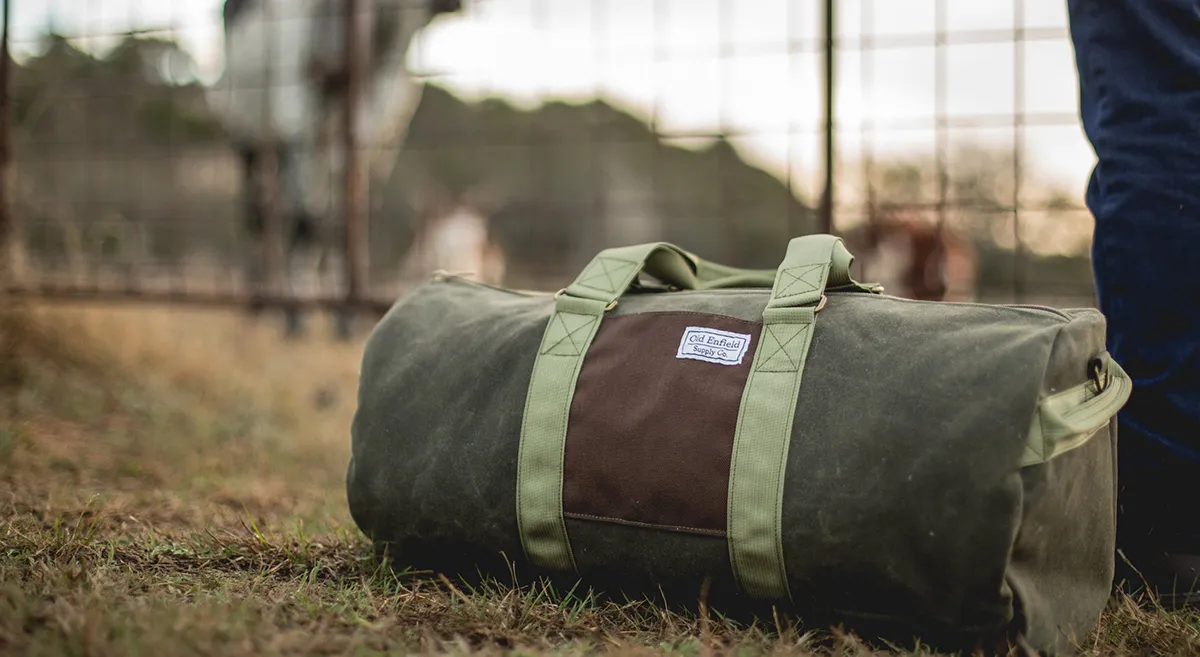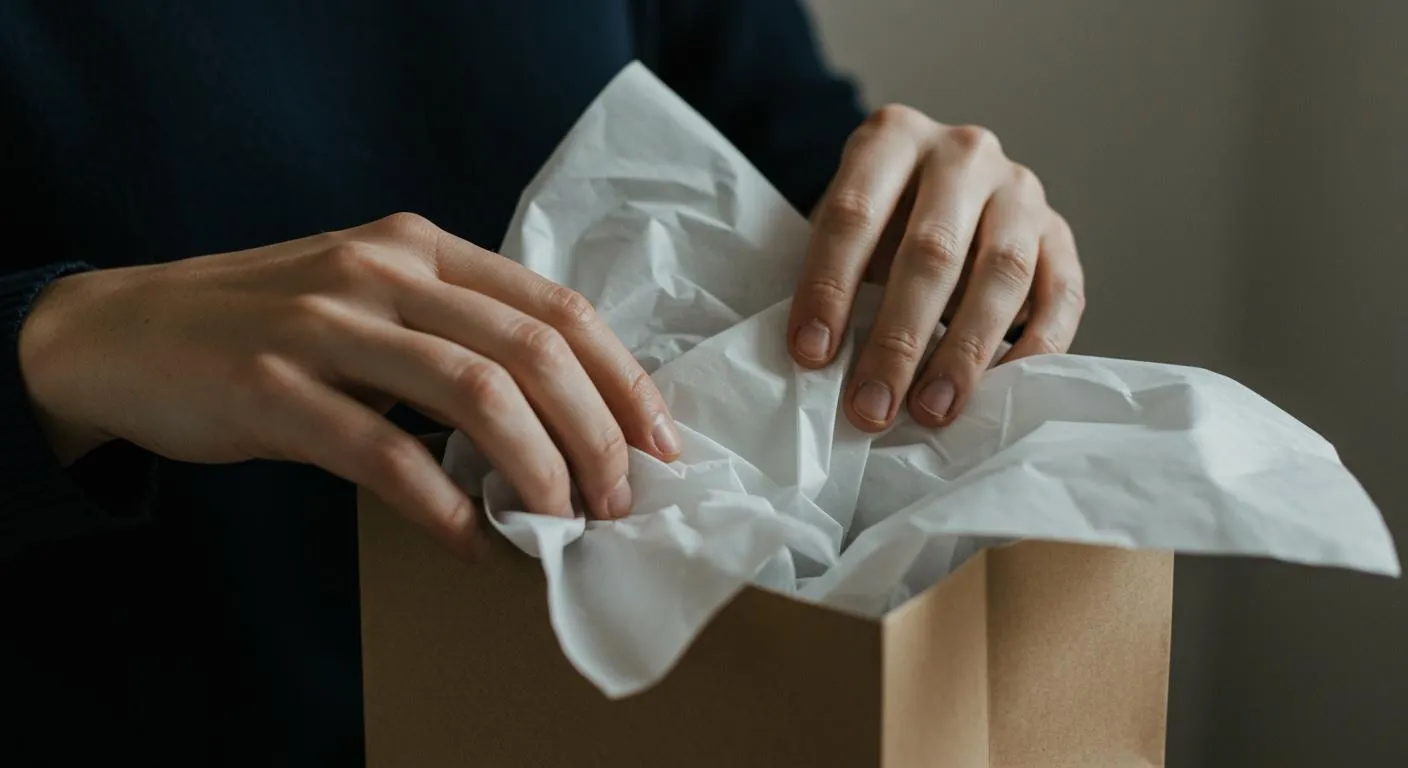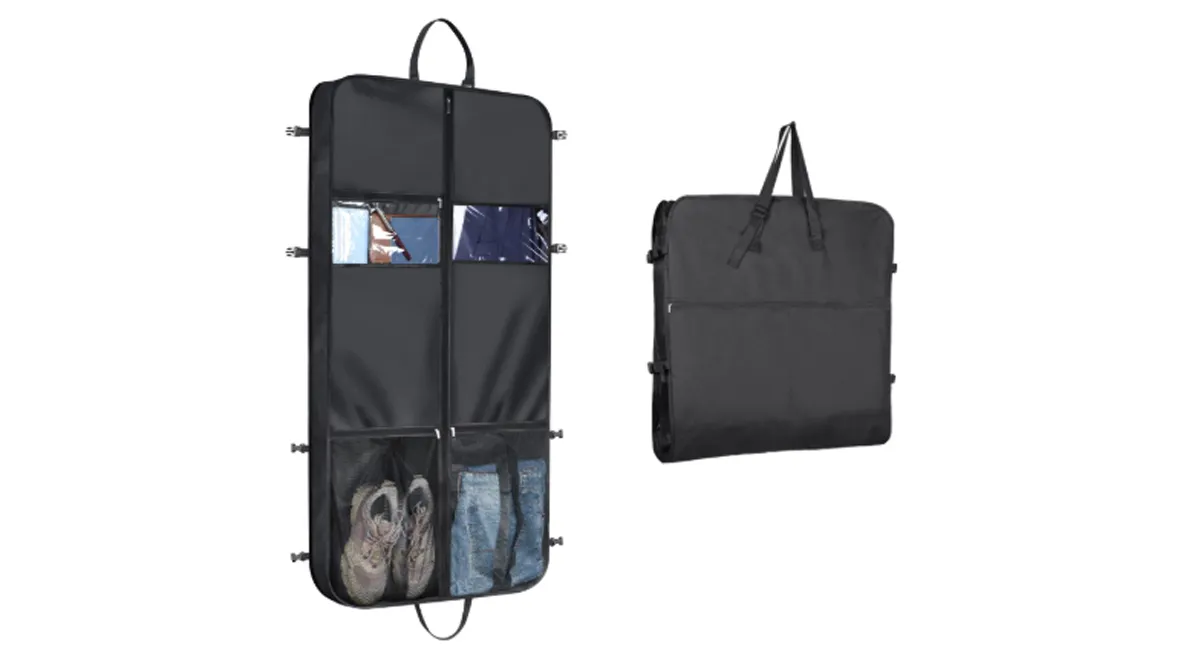What type of shopping bag is more eco friendly? The short answer is that the most eco friendly shopping bag depends on how it is made, how many times it is reused, and which materials it uses. In general, reusable bags made from cotton, canvas, jute, hemp, or recycled non woven fabric perform best because repeated use lowers waste and spreads their production impact across many trips. Compared with single use plastic or paper bags, these sustainable options can deliver a lower environmental impact when reused properly.
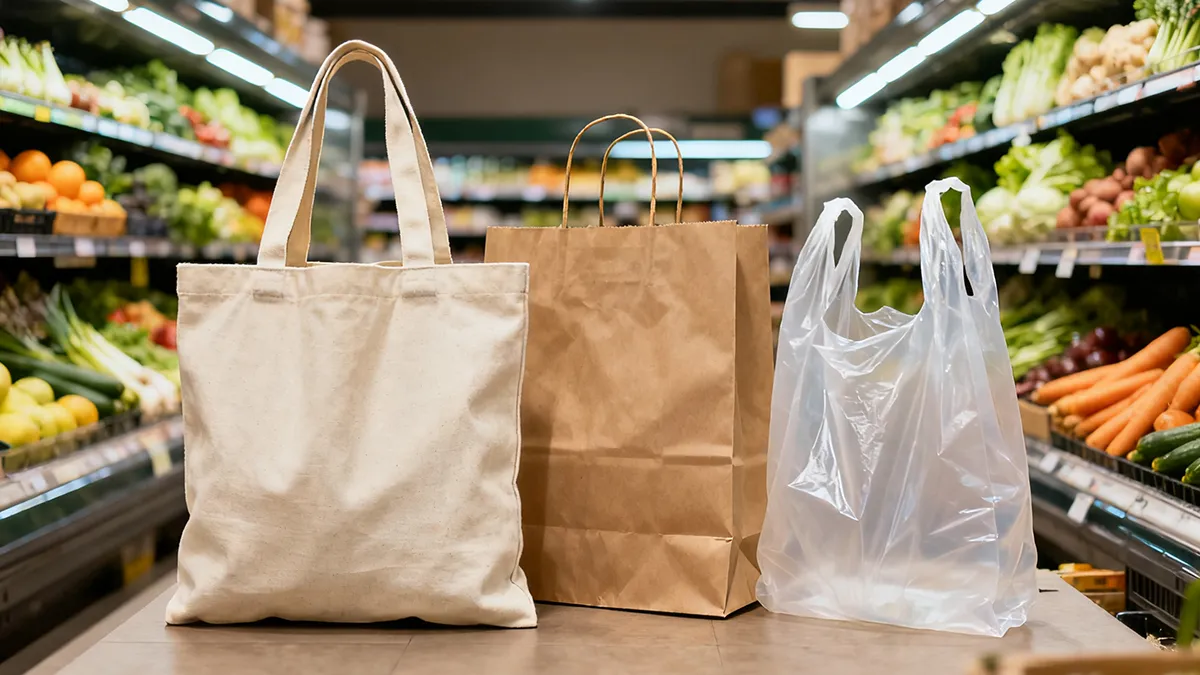
Choosing the right eco friendly shopping bag is not only about avoiding plastic. It requires understanding each bag’s full life cycle from raw material sourcing to reuse, recycling, or disposal. This guide will compare paper, plastic, cotton, and other reusable bags so you can identify the most sustainable choice for daily shopping or your business. Whether you are an individual buyer or a brand seeking greener packaging, you will find practical, data informed tips to make smarter, planet friendly decisions.
Key Takeaways
The most eco friendly shopping bag depends on material, reuse, and disposal. No single bag is perfect — how often you reuse it matters most.
Reusable bags made from cotton, canvas, jute, hemp, or recycled materials are generally better for the planet than single-use paper or plastic.
Production impact varies widely. Paper and cotton require more water and energy, while plastic has low production impact but poor recyclability.
Durability equals sustainability. The longer a bag lasts and the more times it is reused, the lower its carbon footprint becomes.
Choose based on your needs. For groceries, non-woven PP and RPET bags work best; for retail or gifting, kraft, jute, or cotton bags offer a premium, eco conscious look.
Businesses can enhance sustainability by using custom reusable packaging and working with reliable manufacturers like INITI Bag for OEM and ODM solutions.
Why “Eco-Friendly” Isn’t Always Simple
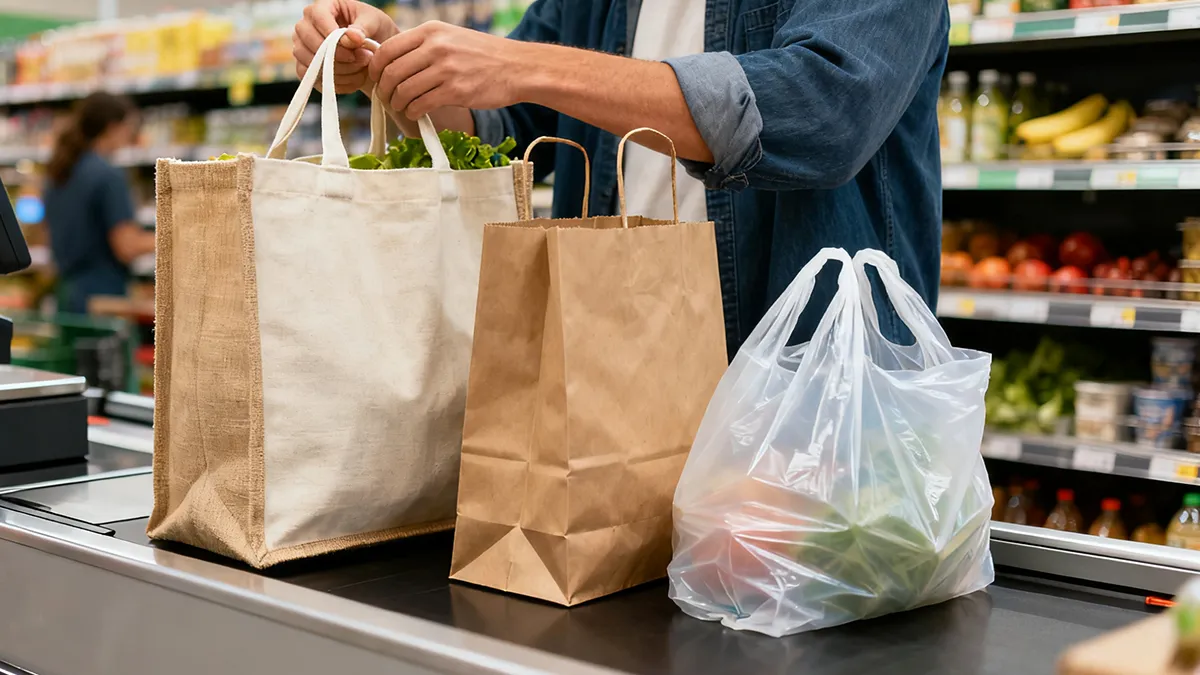
When it comes to finding the most eco friendly shopping bag, the answer is not as simple as choosing paper over plastic. A bag’s true environmental impact depends on its entire life cycle — how it is produced, how many times it is reused, and how it is handled at end of life. This cradle to grave view is called a Life Cycle Assessment (LCA), which measures carbon footprint, energy use, and waste generation for each bag type.
Take plastic bags as an example. They often have a poor public image, yet they typically require less energy and water to produce than paper or cotton. The downside of plastic is weak biodegradability and a higher risk of pollution and microplastics. Paper bags are biodegradable and recyclable, but their production can consume large amounts of water and energy. Cotton and canvas feel sustainable, but they need dozens or even hundreds of reuses to balance the high impact of making them.
Eco friendly is not a one size fits all label. To choose a truly sustainable shopping bag, look beyond the material and weigh durability, reuse potential, and recyclability or disposal pathways. In the next section, we will compare common materials side by side to see which option performs best for the planet.
Comparison by Material – Which Bag Wins?
Plastic Bags (HDPE and LDPE)
Plastic bags are lightweight, cheap to produce, and surprisingly efficient when measured by energy use per bag. They take very little water and energy to make compared to other materials. The problem is what happens after use. Most plastic bags are thrown away, and only a small portion are recycled. They can take hundreds of years to break down, releasing microplastics into soil and water. If reused several times or recycled properly, they can be less harmful, but careless disposal makes them a major environmental concern.
Paper Bags
Paper bags are made from renewable resources and are easy to recycle or compost. They have a better image because they biodegrade quickly, but production is resource intensive. Paper manufacturing consumes large amounts of water and energy, and the bags tear easily, limiting reuse. A paper bag becomes truly eco friendly only when it is made from recycled fiber and reused several times before recycling again.
Cotton and Canvas Bags
Cotton and canvas bags are durable and can last for years. They are comfortable to carry and perfect for repeated use. However, growing cotton requires significant water, pesticides, and energy, especially for organic cotton. To be environmentally efficient, a cotton bag must be reused many times — sometimes more than 100 uses — to balance the footprint of production. When used long term, washed properly, and recycled at the end of life, cotton performs well as a sustainable choice.
Non Woven and Reusable Polypropylene (PP) Bags
Non woven polypropylene bags are one of the best middle ground options. They are lightweight, strong, and can be reused dozens of times. The material is recyclable and can also be made from recycled plastic. These bags have a low production footprint and high durability, making them a popular choice for supermarkets and delivery services. When reused frequently and recycled after wear, they offer excellent overall performance.
Jute, Hemp, and Other Natural Fiber Bags
Bags made from jute, hemp, or other natural fibers are sturdy and biodegradable. They come from renewable plants that grow with minimal chemical use, and they provide a natural, rustic look favored by eco conscious brands. Their production uses less water and fertilizer than cotton, and they can be composted at the end of life. The main trade off is higher cost and slightly heavier weight, but in terms of sustainability, they perform very well.
Mesh and Drawstring Bags
Mesh drawstring bags are lightweight, breathable, and often used for fruits, vegetables, or small retail packaging. They can be made from cotton, polyester, or RPET (recycled PET plastic). Their open weave design makes them reusable and easy to clean. When made from recycled material, they are an excellent eco friendly alternative to single use produce bags.
Comparison Table: Environmental Performance by Material
To help you visualize the differences, here’s a quick comparison of the most common shopping bag materials — summarizing how they perform in terms of production impact, reusability, and end-of-life sustainability. This overview makes it easier to see which option fits your personal or business goals for a greener future.
| Bag Type | Production Impact | Durability / Reuse Count | Recyclability / Disposal | Overall Sustainability |
|---|---|---|---|---|
| Plastic (HDPE/LDPE) | Very low energy and water use; high pollution risk after disposal | 1–5 uses | Limited recycling; long degradation time | Low when single-use, moderate if reused |
| Paper (Recycled Kraft) | High water and energy use; renewable source | 3–5 uses | Easily recyclable and compostable | Moderate when recycled and reused |
| Cotton / Canvas | Very high water and land use; pesticide intensive | 100+ uses | Compostable if untreated | High when reused frequently |
| Non Woven PP (Polypropylene) | Low energy use, durable material | 20–50 uses | Recyclable where facilities exist | High overall due to long lifespan |
| Jute / Hemp | Moderate energy use; renewable, low chemical input | 30–50 uses | Biodegradable and compostable | High due to natural fiber and reusability |
| Mesh / RPET | Moderate impact; made from recycled PET or cotton | 10–30 uses | Recyclable or compostable depending on fiber | Good balance of performance and recyclability |
Life Cycle Analysis – The Science Behind Sustainability
Understanding which shopping bag is truly eco friendly means looking at more than just the material. Life Cycle Analysis (LCA) is a scientific way to measure the total environmental cost of a product from start to finish — including raw material extraction, manufacturing, transportation, reuse, and end of life. It gives a complete picture of the carbon footprint, energy use, and waste generation of each bag type.
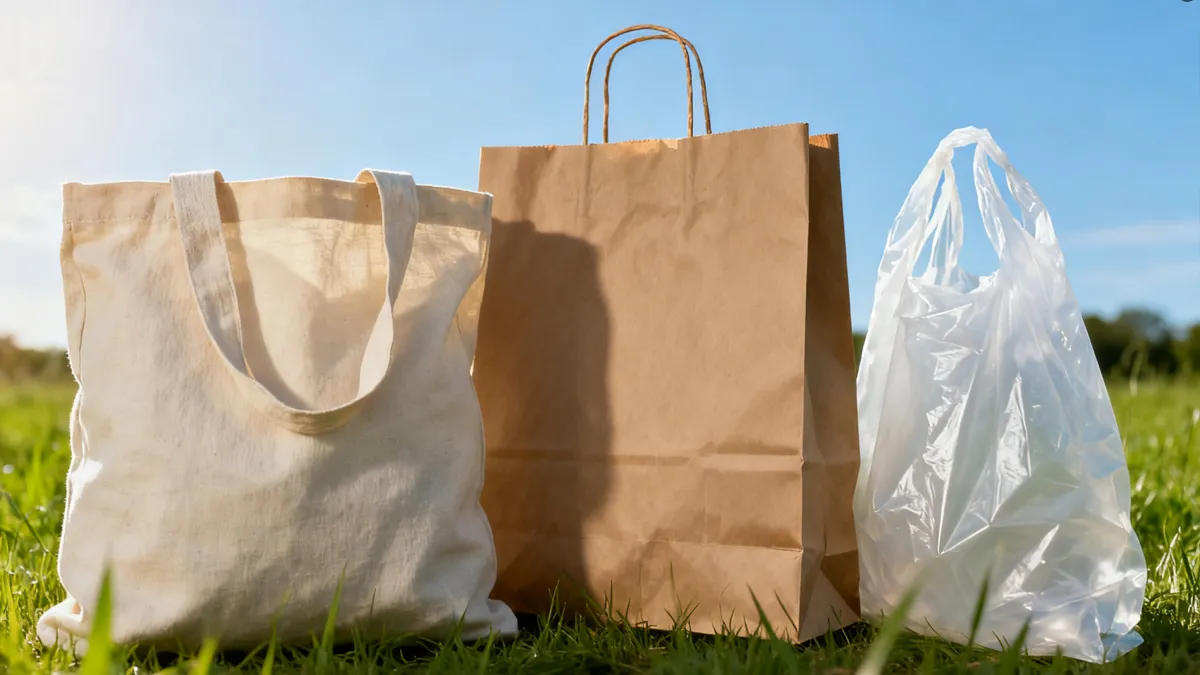
A bag that looks “green” may not perform well when all stages are counted. For example, a cotton tote has a large footprint during production but becomes more sustainable after dozens of uses. A paper bag starts with high water consumption but decomposes quickly. A plastic or non woven bag may have the lowest manufacturing impact, yet only remains eco friendly when reused and recycled properly.
Below is a simplified view of how each material performs when all stages are considered:
| Bag Type | Carbon Footprint (per use) | Water Use | Durability | Recyclability / Disposal |
|---|---|---|---|---|
| Plastic (HDPE) | Low, if reused | Very low | Low | Difficult to recycle, landfill common |
| Paper | Medium | High | Low | Easily recyclable or compostable |
| Cotton / Canvas | High at first, lowers with frequent reuse | Very high | High | Compostable if untreated |
| Non Woven PP | Low | Low | High | Recyclable where facilities exist |
| Jute / Hemp | Medium | Moderate | High | Biodegradable / compostable |
| RPET | Medium | Low | Medium | Recyclable with PET systems |
Key insight: The most sustainable bag is the one that gets reused the most. The environmental benefit increases every time a bag replaces a single use alternative. Reusing, recycling, and choosing responsibly sourced materials all make a much bigger difference than the material name on the label.
Eco-Friendly Doesn’t Mean One-Size-Fits-All
There is no single shopping bag that fits every situation. What works best depends on how and where the bag will be used, how long it will last, and whether it can be reused or recycled locally. In other words, the most eco friendly shopping bag is the one that matches your habits and needs.
For daily grocery shopping, a non woven polypropylene (PP) or recycled PET (RPET) bag is often the smartest choice. These materials are lightweight, durable, and easy to wipe clean. When reused regularly, they have a much lower environmental impact than paper or plastic.
If you need premium packaging for retail or gifting, kraft paper, jute, or cotton canvas bags offer a natural and sustainable look. They can be branded easily with eco friendly inks and reused by customers many times, creating extra brand exposure while supporting sustainability goals.
For restaurants, takeout, and delivery services, corrugated paper or non woven bags with reinforced handles work best. They balance strength, insulation, and recyclability, making them ideal for both food and retail use.
If you sell fresh produce or small retail items, mesh drawstring bags made from cotton or RPET are a great alternative to single use plastic. They are breathable, washable, and perfect for repeated use.
No matter which option you choose, the key is to reuse your bags as often as possible and dispose of them responsibly. A sturdy reusable bag made with sustainable materials can replace hundreds of single use bags over its lifetime.
How to Choose the Right Bag for Your Business
For businesses, choosing the right eco friendly shopping bag is about more than material — it is about finding the balance between brand image, cost efficiency, and sustainability goals. The right packaging not only carries your products but also represents your values to customers.
Start by defining your priorities. If your goal is to build a premium, sustainable brand image, materials like cotton, canvas, kraft paper, or jute work beautifully. These options look natural and high quality, can be easily customized with your logo, and appeal to eco conscious shoppers. For a modern, affordable, and durable solution, non woven polypropylene (PP) or recycled PET (RPET) bags are ideal. They are lightweight, strong, and reusable — perfect for retail, supermarkets, and delivery services.
- Consider your customer behavior
If your customers are likely to reuse the bag many times, invest in durable materials and attractive designs. If your products are often carried once (for example, takeaway food or retail packaging), focus on recycled paper or biodegradable materials that minimize waste.
- Look at local recycling options
Even the best materials lose their eco advantage if they cannot be recycled where your customers live. Check what local facilities accept, and choose materials that fit those systems.
- Think long term
Reusable packaging is not just a trend; it is a cost effective marketing tool. Every time a customer reuses your bag, your brand gains visibility while reducing waste. Choosing the right sustainable packaging strengthens your environmental credibility and builds customer trust.
INITI Bag — Your Partner in Eco-Friendly Packaging
At INITI Bag, we believe that sustainability and quality should go hand in hand. As a professional manufacturer specializing in eco friendly shopping bags and custom packaging, we help businesses around the world create packaging that looks great, lasts long, and respects the planet.
We offer a full range of custom solutions, including OEM and ODM services, so you can design bags that perfectly match your brand and product needs. Our production line supports a wide variety of materials, such as kraft paper, corrugated paper, cotton, canvas, jute, hemp, non woven fabric, RPET, polyester, PVC, and mesh drawstring bags. Whether you need elegant retail gift bags, durable grocery totes, or eco friendly delivery packaging, INITI Bag can make it happen.
Our team focuses on innovation, precision, and sustainability at every step. We use recyclable and biodegradable materials, offer water-based printing, and ensure consistent quality control across large orders. With low minimum order quantities and fast turnaround times, we make it easy for small and large brands to switch to sustainable packaging without compromising design or budget.
Partnering with INITI Bag means choosing a manufacturer that understands both environmental responsibility and market needs. Let’s work together to build packaging solutions that are practical, beautiful, and kind to the planet.
Contact INITI Bag today to learn more about bulk orders, custom designs, and sustainable material options for your business.
Final Thoughts
Choosing the most eco friendly shopping bag is about understanding how materials, reuse, and recycling come together to reduce environmental impact. There is no perfect answer, but making small, consistent changes — like reusing bags, choosing recycled materials, and supporting sustainable manufacturers — can make a big difference.
If your business is ready to take the next step toward sustainability, INITI Bag is here to help.
Contact us today to create custom, eco friendly shopping bags that make your brand — and the planet — shine brighter.
FAQs About Eco-Friendly Shopping Bags
Are paper bags more eco friendly than plastic bags?
Not always. While paper bags are biodegradable and recyclable, they require a lot of water and energy to produce. Plastic bags, on the other hand, have a lower carbon footprint per unit but are difficult to recycle and can cause pollution if not disposed of properly. The best choice depends on how many times the bag is reused and how it is managed after use.
How many times should I reuse a cotton or canvas bag to make it sustainable?
A cotton or canvas bag becomes truly eco friendly after being reused more than 100 times. This is because cotton farming and weaving consume significant water and energy. The more you reuse it, the smaller its environmental impact becomes over time.
What is the most sustainable material for shopping bags?
The most sustainable materials are those that combine durability, reusability, and recyclability. Non woven polypropylene (PP), recycled PET (RPET), jute, and hemp are top choices. These materials are strong, have moderate production impacts, and can be reused many times before recycling or composting.
Are biodegradable or compostable bags better for the environment?
Yes, but only under the right conditions. Biodegradable bags break down naturally, while compostable bags need industrial composting facilities to decompose completely. If they end up in regular landfills, the environmental benefits are limited. The key is ensuring proper disposal.
How can businesses switch to eco friendly packaging effectively?
Start by assessing your current packaging materials and identifying alternatives made from recycled or renewable sources. Choose a reliable manufacturer that provides custom OEM and ODM services, like INITI Bag, to design packaging that fits your brand while reducing waste. Reusable, recyclable, and biodegradable materials not only support sustainability but also enhance brand image and customer trust.


